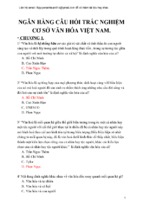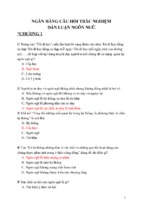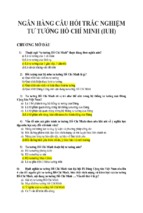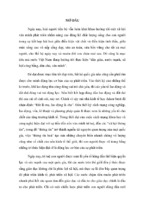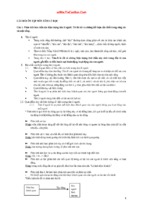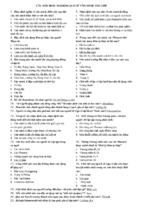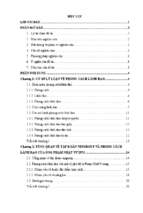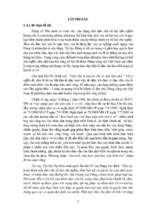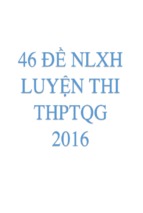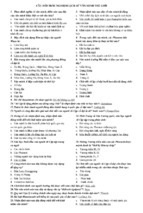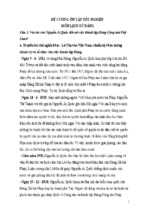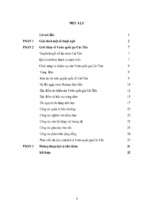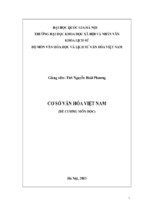THAI NGUYEN UNIVERSITY
SCHOOL OF FOREIGN LANGUAGES
DANG THI LE THUY
FACTORS AFFECTING LISTENING COMPREHENSION
OF THE 8TH GRADE STUDENTS AT A JUNIOR
HIGH SCHOOL IN THAI NGUYEN CITY
(Những yếu tố ảnh hưởng đến khả năng nghe hiểu
của học sinh lớp 8 tại một trường Trung học cơ sở ở
Thái Nguyên)
M.A THESIS
Field: English Linguistics
Code: 8220201
THAI NGUYEN – 2019
Số hóa bởi Trung tâm Học liệu và Công nghệ thông tin – ĐHTN
http://lrc.tnu.edu.vn
THAI NGUYEN UNIVERSITY
SCHOOL OF FOREIGN LANGUAGES
DANG THI LE THUY
FACTORS AFFECTING LISTENING COMPREHENSION
OF THE 8TH GRADE STUDENTS AT A JUNIOR
HIGH SCHOOL IN THAI NGUYEN CITY
(Những yếu tố ảnh hưởng đến khả năng nghe hiểu
của học sinh lớp 8 tại một trường Trung học cơ sở ở
Thái Nguyên)
M.A THESIS
Field: English Linguistics
Code: 8220201
Supervisor: Nguyen Thi Minh Loan Ph.D
THAI NGUYEN – 2019
Số hóa bởi Trung tâm Học liệu và Công nghệ thông tin – ĐHTN
http://lrc.tnu.edu.vn
DECLARATION
I certify that this thesis paper is the result of my own research and the substance
of the research has not been submitted for a degree to any other university or
institution.
I assure that all references and citations to ensure the correctness, accuracy and
honesty.
Thai Nguyen, July 2019
Author’s signature
Dang Thi Le Thuy
Số hóa bởi Trung tâm Học liệu và Công nghệ thông tin – ĐHTN
http://lrc.tnu.edu.vn
ACKNOWLEDGMENT
For the completion of this thesis, I have received great assistance and support
from many people without whom the work could not have been fulfilled
First and foremost, I would like to express my deepest gratitude and my
profound appreciation to my supervisor, Dr. Nguyen Thi Minh Loan- from Thai
Nguyen University, School of foreign languages for her guidance, precious
suggestions, invaluable critical feedback and encouragement in the process of
completing this thesis.
I would also like to express my sincere thanks to all the lecturers of the School
of Foreign Languages, Thai Nguyen University for their interesting lectures and
suggestions for the topic of my study.
Thanks are also due to my students grade 8 and my colleagues at a Junior High
School, Thai Nguyen City for their assistance and cooperation in completing the
questionnaires and interviews
Last but not least, I would like to give my deepest gratitude to my parents, my
husband and my friends for their moral support and encouragement throughout my
training course.
Số hóa bởi Trung tâm Học liệu và Công nghệ thông tin – ĐHTN
http://lrc.tnu.edu.vn
ABSTRACT
The aim of the study was to discover the factors affecting the listening
comprehension of 8th-grade students at a junior high school in Thai Nguyen. The
participants of the study included 90 grade 8 students from classes 8A1, 8A2, 8A3
and 5 teachers of English at Nha Trang junior high school in Thai Nguyen. In this
article, researchers had looked at the terms listening, listening comprehension,
factors that affect listening comprehension. After conducting the research steps, the
researcher discovered factors that more or less affected the listening comprehension
of grade 8 students such as, process, task, listener, input, affect, and context. Among
these factors, it was found that specific problems that affected students' listening
comprehension were: grammar, structure and vocabulary, accents, speaking speech,
unfamiliar topics and poor listening equipment. The finding of the research indicated
that when teachers were aware of the factors that affected students’ listening
comprehension, they could help their students develop effective listening strategies
and ultimately solve those difficulties in listening and improved listening
comprehension.
Số hóa bởi Trung tâm Học liệu và Công nghệ thông tin – ĐHTN
http://lrc.tnu.edu.vn
TABLE OF CONTENTS
DECLARATION ........................................................................................................ i
ACKNOWLEDGMENT ............................................................................................ ii
ABSTRACT .............................................................................................................. iii
TABLE OF CONTENTS .......................................................................................... iv
LIST OF TABLES .................................................................................................... vi
CHAPTER 1: INTRODUCTION ............................................................................1
1.1. Rationale for the study .........................................................................................1
1.2. Aims of the study .................................................................................................2
1.3. Significance of the study ......................................................................................2
1.4. Scope of the study ................................................................................................3
1.5. Organization .........................................................................................................3
CHAPTER 2: LITERATURE REVIEW ................................................................4
2.1. Listening comprehension .....................................................................................4
2.1.1. Definition ..........................................................................................................4
2.1.2. Listening comprehension process .....................................................................5
2.2. Factors affecting listening comprehension ..........................................................6
2.2.1. Definition ..........................................................................................................6
2.2.2. Taxonomy of factors affecting listening comprehension ..................................7
2.3. Previous studies on factors affecting listening comprehension ...........................9
2.4. Summary ............................................................................................................12
CHAPTER 3: METHODOLOGY .........................................................................13
3.1. Subjects of the study ..........................................................................................13
3.2. Data collection instruments. ...............................................................................13
3.2.1. Questionnaire (see Appendix 1) ......................................................................13
3.2.2. Interview .........................................................................................................15
3.3. Procedures of data collection .............................................................................16
3.4. Data analysis ......................................................................................................17
3.5. Summary ............................................................................................................17
Số hóa bởi Trung tâm Học liệu và Công nghệ thông tin – ĐHTN
http://lrc.tnu.edu.vn
CHAPTER 4: FINDINGS AND DISCUSSION ...................................................18
4.1. Findings ..............................................................................................................18
4.1.1. Findings of the questionnaire ..........................................................................18
4.1.2. Findings of the interview ................................................................................26
4.2. Discussion ..........................................................................................................27
4.3. Summary ............................................................................................................30
CHAPTER 5: IMPLICATIONS AND CONCLUSION ......................................31
5.1. Implications ........................................................................................................32
5.1.1. For teachers .....................................................................................................32
5.1.2. For students .....................................................................................................35
5.2. Limitations of the study .....................................................................................37
5.3. Suggestions for future research ..........................................................................37
5.4. Conclusion ..........................................................................................................38
REFERENCES ........................................................................................................38
APPENDIX .............................................................................................................43
Số hóa bởi Trung tâm Học liệu và Công nghệ thông tin – ĐHTN
http://lrc.tnu.edu.vn
LIST OF TABLES
Table 1: Students' choices about factors that affected their listening comprehension.....18
Table 2: Process factor ..............................................................................................20
Table 3: Task Factor..................................................................................................21
Table 4: Input Factor ................................................................................................22
Table 5: Listener Factor ............................................................................................23
Table 6: Affect Factor ...............................................................................................24
Table 7: Context Factor .............................................................................................25
Số hóa bởi Trung tâm Học liệu và Công nghệ thông tin – ĐHTN
http://lrc.tnu.edu.vn
CHAPTER 1: INTRODUCTION
1.1. Rationale for the study
Listening is an important language skill to develop in second language learning.
Despite its significance, language learners consider listening as the most difficult
language skill to learn. Moreover, listening is the most important skill in language
learning because it is the most widely used language skill in normal daily life.
Listening has an important role not only in daily life but also in the classroom
environment. Most people believe that being able to write and speak in a second
language means that they know the language. However, if they do not have efficient
listening skills, it is impossible to communicate effectively. That is, listening is the
basic skill in language learning. Listening is vital in the language classroom because
it provides input for the learner. Without understanding input on the right level, any
learning simply cannot start.
A lot of research has been done on this issue (Chang & Roebl, 2011, Kutlu
&Aslanolub, 2009). The results of previous studies have largely supported the
difficulty of listening to new languages from the text, listeners, speakers, and tasks.
Almost all previous studies in listening skills and listening comprehension skills have
identified important factors affecting the ability of the learner’s listening
comprehension such as process, input, listener, task, affect and context factors.
However, the subjects of those studies were often high school and university students
in Vietnam or other non-English speaking countries.
In Vietnamese schools, especially in Nha Trang junior high schools in Thai
Nguyen, most students thought that learning the listening skills was the hardest, and
some students thought the listening skills were relatively new, even though the
students experienced the least English learning 3 years in primary school and in grade
6, 7. Meanwhile, the period of training at junior high school according to the
distribution of each semester was more than 50 periods (3 periods/ week), in 18 weeks
in a semester, the amount of time spent on listening comprehension was too little.
Số hóa bởi Trung tâm Học liệu và Công nghệ thông tin – ĐHTN
http://lrc.tnu.edu.vn
Less time was spent on self-study, and fewer students could practice listening at home
from 1 to 2 hours a week. Another worry thing was that most students read the
typescript before practicing their listening skills. Hence, it was a bad habit that made
the listening process not meet the requirements and goals of the curriculum.
Therefore, identifying the factors that directly or indirectly affected the listening
skills of 8th graders was very important. These factors would help students realize
their own difficulties, and they could find the best solution to overcome these factors,
and also help teachers to look more about the factors that affect their students'
listening comprehension to give solutions and teaching listening, toward a goal that
all students can listen in the best way.
With the current situation relating to the students’ poor listening comprehension
competence at Nha Trang junior high school, the researcher conducted this study to
find out factors that affected the 8th-grade students’ listening comprehension at Nha
Trang junior high school in Thai Nguyen. It was hoped that the findings of this paper
could provide good views for the teaching and learning of listening comprehension
at school.
1.2. Aims of the study
The purpose of this study was to identify factors that affected the listening skills of
eighth graders. This helped students identify the importance of listening skills and
develop it better.
In this study, the following research question was answered:
- What factors affect the listening comprehension of the 8th-graders?
1.3. Significance of the study
The findings of this study brought a lot of meaning to teachers, students as
well as researchers. First, for English teachers, this study was able to provide more
in-depth information so that teachers could actively help students improve their
listening skills. Besides, this study was able to provide suggestions and
Số hóa bởi Trung tâm Học liệu và Công nghệ thông tin – ĐHTN
http://lrc.tnu.edu.vn
recommendations for English teachers to prepare English listening lessons more
effectively, enabling students to improve listening comprehension as well as daily
language communication. Second, this study also played an important role for
students to be aware of their listen ability. They could recognize the factors that
affected their learning to listen skills so that they could find ways to improve their
listening ability. Last but not least, for other researchers who would carry out a similar
study, the results of this study were considered a reference and contributed more
information to solve the same problem.
1.4. Scope of the study
The research was conducted on 90 students of 8th-grade and 5 English teachers
from Nha Trang junior high school in Thai Nguyen city. It focused on the factors that
affected the student’s listening comprehension.
1.5. Organization
The study included five main chapters: introduction, literature review,
methodology, findings and discussion, implications and conclusion.
Chapter 1: Introduction, presented basic information such as theoretical basis,
purpose, research questions, meanings, scope, significance as well as the design of
the study.
Chapter 2: Literature review, considered different views on listening
comprehension, listening processes, factors affecting listening comprehension,
classification of influencing factors as well as previous studies about factors affecting
students' listening skills.
Chapter 3: Methodology, mentioned the method of conducting research including,
research topics, research questions, data collection tools (questionnaires and
interviews), data collection steps and data analysis.
Chapter 4: Findings and discussion, presented research findings and discussed
research questions.
Chapter 5: Implication and conclusion, pointed out the implications of the study,
some limitations and made research conclusions.
Số hóa bởi Trung tâm Học liệu và Công nghệ thông tin – ĐHTN
http://lrc.tnu.edu.vn
CHAPTER 2: LITERATURE REVIEW
This chapter discussed the theory and previous research on areas that form the
basis of this research. The first section provided an overview of listening
comprehension and common listening processes. The second part provided a
definition of the factors affecting the listening process and the classification of
previous researchers on those factors. The final part was an assessment of previous
relevant studies conducted by researchers.
2.1. Listening comprehension
2.1.1. Definition
There have been different definitions of the term “listening comprehension.” Rost
(2002) and Hamouda (2013) defined listening comprehension is an interactive
process in which listeners engage in building meaning. The listener understands oral
input through sound distinction, previous knowledge, grammatical structure, stress
and intonation and other linguistic or nonverbal clues (as cited in Pourhosein Gilak
camera & Sabouri, 2016).
Listening is not a passive skill, but an active, receptive skill. It requires a lot of
attention and mental activity like speaking. And listening comprehension is an act of
understanding an oral message. Listening is an extremely complex operation (Buck,
2001) requires more than simple perception of audio signals.
It involves speech decoding and comprehending. Listening comprehension is not
something that happens because of what the speaker speaks, but follow Anderson &
Lynch(1988: 6) the listener plays an important role in the listening process, by
activating various types of knowledge and by applying what listener knows to what
listener hears and trying to understand what the speaker speaks.
Nadig (2013) defined listening comprehension is different processes to understand
and make sense of spoken language. These involve knowing speech sounds,
understanding the meaning of individual words and understanding the syntax of
Số hóa bởi Trung tâm Học liệu và Công nghệ thông tin – ĐHTN
http://lrc.tnu.edu.vn
sentences (as cited in Pourhosein Gilakjani & Sabouri, 2016). According to Brown
and Yule (1983) and Hamouda (2013), listening comprehension is a personal
understanding of what he has listened and that is the possibility that the listener can
repeat the text despite the fact that the listener can repeat the sound without real
understanding.
Therefore, listening comprehension might be defined as understanding what the
speaker had said. Listeners play a particularly important role in the listening process
by using their own knowledge to listen and understand what the listeners listen so
that they can understand the speech of the speaker.
2.1.2. Listening comprehension process
Listening comprehension is the ability of one individual perceiving another based
on sense, (specifically aural) organs, having meaning to the message and
comprehending it. According to Steinberg (2007), listening is more complicated than
just hearing. This process consists of four stages: feeling and attending, understanding
and explaining, remembering, and answering. The stages happen in sequence, but we
often don't know them.
Schemata are instructional structures during listening comprehension. A schema is
a data structure to display common concepts stored in memory. Schema means an
abstract text structure that listeners use to understand the text. Listeners use language
signals and situations on new inputs to extract schemata. When a schema is extracted,
it becomes a guiding structure in listening comprehension. If there is a harmony
between the incoming information and the schema, the listener will understand the
text. Schema leads to three basic information processing modes: bottom-up process,
top-down process and interactive process (Pourhosein Gilak camera & Ahmadi,
2011).
Bottom-up process
The listener uses their knowledge of the language and their ability to process
acoustic signals to make sense of the sounds that speech presents to them.
Số hóa bởi Trung tâm Học liệu và Công nghệ thông tin – ĐHTN
http://lrc.tnu.edu.vn
Top-down process
The listener infers meaning from contextual clues and from making links between
the spoken message and various types of prior knowledge which they hold.
Interactive Process
According to interactive processing, top-down and bottom-up listening should be
combined to increase listening comprehension. Application of basic knowledge
information, contextual information and language information makes it easy to
understand and explain. When the content of the document is familiar to the listener,
he uses his background knowledge to make predictions proved by new inputs. If the
content of the text sounds unfamiliar to the listener, he can only use his linguistic
knowledge, especially vocabulary knowledge and syntax to understand information
(Pourhosein Gilak camera & Ahmadi, 2011). Understanding includes awareness,
parsing and use. Perceptual processing is the coding of auditory messages or text
messages and it includes chunking phonemes from continuous speech.
To sum up, based on the schemata structure, there were three basic modes of
information processing: bottom-up process, top-down process, and interactive
process. In each processing, learners might have different difficulties. For example,
in bottom-up processing, learners might not know how to make links between the
spoken message and various types of prior knowledge they learned. In top-down
processing, they might lack ability to process acoustic signals. Besides, in the
interactive processing, top-down and bottom-up listening processing should be
combined with each other to increase listening comprehension. Therefore, it is
important to find out the factors that affect the listening process.
2.2. Factors affecting listening comprehension
2.2.1. Definition
Goh in Hamouda (2013) defined listening difficulties are all the internal and
external characteristics that interrupt the understanding process directly related to
cognitive procedures at various stages of listening comprehension. It can be stated
Số hóa bởi Trung tâm Học liệu và Công nghệ thông tin – ĐHTN
http://lrc.tnu.edu.vn
that listening difficulties are the characteristic that disturbing the listener in
comprehending the information.
Therefore, factors affecting listening comprehension might be defined as all
internal and external factors, subjective or objective, which directly affected the
perception during the listening process.
2.2.2. Taxonomy of factors affecting listening comprehension
There were various factors affected the listening comprehension in the listening
process. Alderson et al. (2006), Bridley and Slatyer (2002), Kostin (2004), Ying-hui
(2006), Wagner (2010), Rost (2011) and others have synthesized several factors that
were likely to influence performance and interpretation of test results. Rubin (1994)
was the first to classify listening factors into five categories, including text,
interlocutor, task, listener and process factors. Based on Jamieson et al.‘s (2000)
learner process models during listening tests, Rost (2011) added a number of
variables that might affect listeners‘ test performance during each stage. These
variables included the stimulus variable, listener variable, and item variable.
Kutlu and Aslanolub (2009), conducted research on the factors affecting listening
skills, and they found that “number of juvenile books at home”, “number of books at
home”, “time spent reading books”, “time spent reading newspaper” and “time spent
listening to radio” have significant effect on fifth grade students’ success in their
listening comprehension.
Unlike previous studies, Lotfi (2012) conducted a discovery factor analysis of the
answers of a sample of Iranian EFL learners and then divided into six distinct factors:
process, input, listener, task, affect, and context by designed a questionnaire to assess
EFL learners’ beliefs about the English listening comprehension problems they may
encounter in unidirectional listening.
The first factor or process factor reflected the problems that learners often have to
deal with different aspects of the listening process. The process here refers to “the
way in which learners use different kinds of signals to interpret what they hear”. In
Số hóa bởi Trung tâm Học liệu và Công nghệ thông tin – ĐHTN
http://lrc.tnu.edu.vn
fact, items loaded on this factor described learners' beliefs about problems related to
two types of processing identified by Rubin (2009), that was, using cognitive and
metacognitive strategies while listening. Some items dealt with the difficulties
learners believe they had in applying cognitive strategies of between-parts
inferencing, prediction, personal elaboration, linguistic inferencing, summarization,
contextualization and listen for the main idea. Some other items dealt with the
difficulties learners believe they had in using metacognitive strategies of planning,
monitoring and evaluation.
Besides, input factor represented learners' beliefs on problems related to different
aspects of the audio input. The input here was defined as the system that provides
linguistic data to the learner's hearing during listening. The factor contained problems
related to such input characteristics as vocabulary, speech clarity, the grammatical
structure of the text speech rate, prosodic features, accent, pause, and text length.
Moreover, the factor listener reflected learners' beliefs about listeners'
characteristics identified as having a considerable effect on second language learners'
listening comprehension and contained learners' problems associated with
characteristics, such as attention, attitude, and memory.
The fourth factor, labeled task, includes three items about problems associated with
characteristics of listening tasks as task type, type of responses demanded when
answering global and local questions.
The fifth factor labeled affect consisted of learners effective responses to instances
of comprehension failure are reflected and regarded the level of anxiety they
experience in listening.
The last factor, context factor, reflected learners’ beliefs about unfavorable
characteristics of the learning context affecting listening comprehension. The factor
included problems about the adverse effect of distracters available in the learning
context on their listening comprehension.
Số hóa bởi Trung tâm Học liệu và Công nghệ thông tin – ĐHTN
http://lrc.tnu.edu.vn
After studying the taxonomies of the factors that affected the ability of students
listening comprehension, the researcher felt that Lotfi’s taxonomy (2012) was very
relevant to this research because, among all taxonomies of listening difficulties,
Lofti’s taxonomy was one of the most comprehensive classifications. Besides, his
taxonomy showed the most specific factors that affected the listening comprehension
of the students. Therefore, the researcher chose his taxonomy as a basic of data
collection instrument in the present study.
2.3. Previous studies on factors affecting listening comprehension
In the past, there was a great deal of research on the listening area of students of
all ages and especially about the factors that affected students' listening
comprehension.
In the last decades, many studies on the effect of specific factors on the learner‘s
listening comprehension was pointed out (e.g. Boyle, 1984; Brown, 1995; Chang &
Roebl, 2011; Chiang & Dunkel, 1992; Lotfi, 2012; Rubin, 1994; Rubin & Thompson,
1994; Teng, 2002; Yagang, 1993).
Boyle (1984) in his study has elaborated the factors that affecting listening
comprehension into two characteristics: speaker and listener. This Hong Kong study
began with a survey of the factors most frequently mentioned in the literature on
listening comprehension. Then a cross-section of teachers working at secondary and
tertiary levels was consulted. Finally, a sample of students who had just finished their
secondary education was questioned. He pointed out the speakers characteristic into
4 items: language ability of the speaker speak production; pronunciation, accent,
variation, voice, etc. speed of delivery, and prestige and personality of the speaker.
Meanwhile, he classified the listener factors into two, general and specific.
The research of Janet Yu-gi Chao (2013) was conducted with the aim to investigate
non-English majors‘English listening performance and listening problems. Seventyfive college students participated in the study. The instruments comprised of a
General English Proficiency Test (GEPT) at the intermediate level and a Listening
Số hóa bởi Trung tâm Học liệu và Công nghệ thông tin – ĐHTN
http://lrc.tnu.edu.vn
Comprehension Problem Questionnaire (LCPQ). The results showed that the
listening problems met by the subjects were mainly from the input factor, followed
by the listener factor and the task factor. Most frequently encountered listening
problems included easily forgetting the content, long listening texts, not knowing
which strategy to use, unclear pronunciation, and unfamiliar intonation patterns. The
proficient listeners identified their main problem as easily forgetting the content when
hearing new words as the foremost problem. The less proficient listeners identified
difficulty to focus on the text while having trouble understanding as the major
obstacle. Finally, significant differences existed in listening problems encountered by
students from different colleges.
Asriati
(2017)
conducted
research
about
listening
comprehension
in
Muhammadiyah University of Makassar, South Sulawesi. This research aimed to
identify the factors affecting the students' listening comprehension achievement and
to identify which factor was dominant, conducted at the Muhammadiyah University
of Makassar. This research was restricted into listener and speaker factors that caused
difficulties. The method of this research was descriptive research. The result of this
research showed that there were 25 factors from the listener and speaker that affected
the students' listening comprehension achievement. Moreover, among those 25
factors, there were 5 factors classified to be the most dominant ones. They were:
inability to acknowledge the colloquial words and slang, inability to understand the
reduced word, inability to answer the question of which required the long answer,
focus loss resulted from looking for the answer to the question and the speed of the
speech delivery.
In Vietnam, studies on this issue had also been done a lot, including a research
about factors in learning the listening skills by Kieu Thi Thu Huong (2014).
This study was conducted to understand the current status of listening comprehension
skills English for International Relations of Foreign Officers, detecting factors that
make it difficult to learn and suggest some corrective measures. This study used
qualitative and quantitative methods. To make sure the validity and reliability of the
Số hóa bởi Trung tâm Học liệu và Công nghệ thông tin – ĐHTN
http://lrc.tnu.edu.vn
study, the researcher used questionnaires, interviews and observations to collect data.
The factors that obstruct the learner's English ability to learn can be classified into
two major categories. Subjective causes include five subgroups: (i) language
knowledge, (ii) listening strategies, (iii) background knowledge and cultural
knowledge, (iv) psychology and health, and (v) learner. Objective causes include (i)
message quality, (ii) facilities, (iii) trainers, and (iv) learning materials.
Another research was undertaken by Nguyen Ngoc An (2015). This study aimed
to investigate the non-specialized students’ listening comprehension in order to have
suitable solutions in learning and teaching. Based on the results of the questionnaires,
the factors that affected the learning of listening as well as the training of listening
skills of students are the limited time of learning listening skills in the classroom, the
uneven condition of the class or psychological student anxiety. The lack of cultural
knowledge of the student and the impact of equipment also affected the students’
listening.
According to the study, listening comprehension was very important in learning
foreign languages. The studies mentioned above explored specific factors that affect
the comprehension of students of different ages. However, there were some
limitations that existed in the studies mentioned. Although some researchers have
done their research with previous studies, but the factors affecting the 8th graders’
age were unclear while their listening comprehension could be said that limited. It
could be said that findings from previous studies had provided good evidence of the
factors that affected students' ability to listening and support the problem in this study.
To fill this gap, the researcher decided to conduct a study to discover clearly the
factors that might affect the listening comprehension of the 8th-grade students in Nha
Trang junior high school in Thai Nguyen city. The study would also highlight the
finding of factors that directly and indirectly might affect students' daily listening
comprehension. It was hoped that this research would contribute to a better
understanding of junior high schools students as well as in Vietnam to help to teach
and learning English listening better.
Số hóa bởi Trung tâm Học liệu và Công nghệ thông tin – ĐHTN
http://lrc.tnu.edu.vn
2.4. Summary
Chapter 2 had described the background used as the foundation of the present
study. Firstly, listening comprehension skill in language learning was discussed.
Next, there were factors that might affect students’ listening comprehension ability.
Finally, previous studies conducted on factors affecting listening comprehension of
different ages were addressed. The review indicated that from these studies, it had
been shown that listening comprehension skills played a very important role in
learning to communicate in this language. In this regard, previous studies also
presented many different factors that affected students' ability to comprehend and
they also offered deep suggestions and recommendations to help students improve
their listening skill better.
Số hóa bởi Trung tâm Học liệu và Công nghệ thông tin – ĐHTN
http://lrc.tnu.edu.vn
- Xem thêm -

